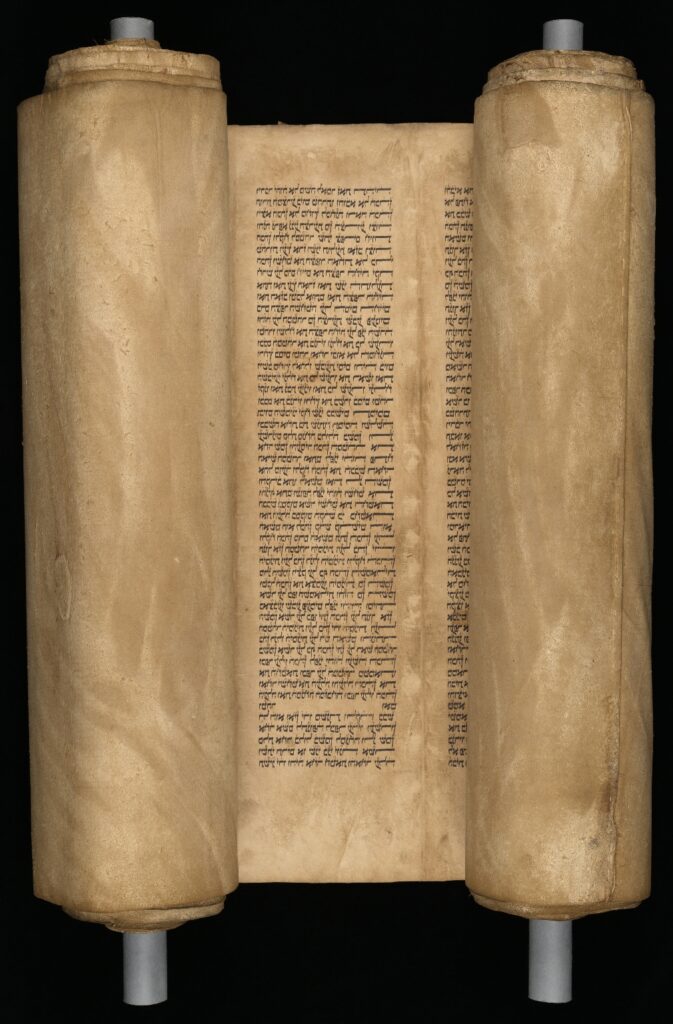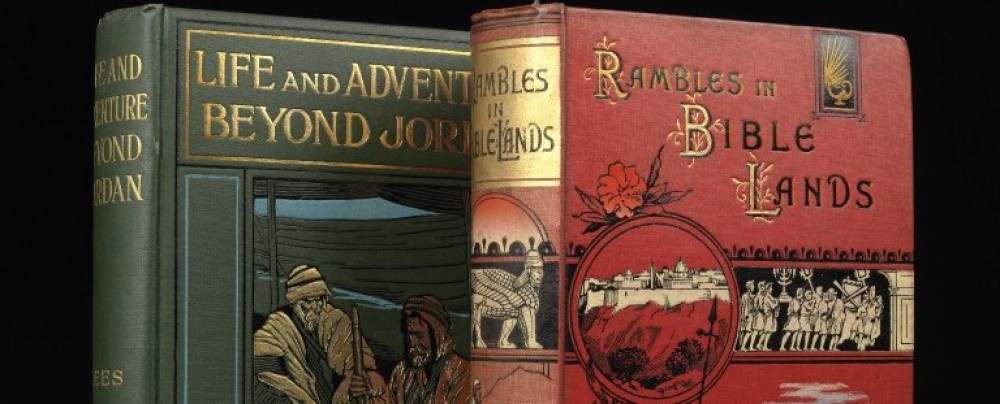A guest post by Valentina Flex, New College Library & Archive Assistant.
In order to ensure the safe and successful decant of collections at New College Library, myself and my fellow Archive and Library Assistants have wrapped (with acid-free tissue paper or Tyvek) and cotton-taping tied particularly fragile objects within the archives in order to stabilise and reinforce them before they move. The preparation for this task involved surveying the collections and taking notes of items in need of special attention. Surveying the items in New College Library archives and assessing the best method of collections care for them made me think about the context of each object’s creation and use. Specifically, I wondered if there were any implications involving certain items in a religious setting that would affect the ways we treat and care for them.

Torah Scroll, New College Library
This inspired me to learn more about the ways in which certain religious beliefs govern the use, storage and display of sacred items and texts. My reading has, so far, been focused on Judaism and the Torah scroll as we have several Hebrew scrolls within the New College archive. One example of such objects held within the collections is pictured below. Although I expected to find many strict rules surrounding such a holy object, the more I read up on the Torah, the more similarities I found between the way it is treated in a religious context and the ways in which we think about our collections in the cultural heritage sector. Below, I’ll give a quick summary of some of the things I’ve learnt about respectful use and handling of the Torah before elaborating a little on the ways in which I think some of these rules coincide with our priorities as cultural heritage professionals. I’ll include some links at the end of this piece to places you can visit to learn more about the topics I’ve discussed.
The main thing I have learnt whilst reading about the Torah scroll is that it is the most important item within the Jewish religion. It contains the entire text of the Five Books of Moses which, according to Jewish tradition, were revealed to Moses on Mount Sinai. This divine origin is interpreted differently across Jewish religious movements; however, respect for the Torah scroll is shared by all.
As such, every effort is made to preserve the writing and so each Torah scroll is handwritten by specially trained scribes who replicate the text according to exact specifications. The Torah scroll is made from parchment using certain inks and writing implements, in order to keep it clean and fit for use, or Kosher. Kosher, in this context means that the materials used in the production and handling of the Torah scroll have to comply with Jewish dietary laws known as Kashrut which forbid the consumption of certain foods and animals (such as pig and shellfish). This has significant implications for the ethical and respectful conservation and treatment of Torah scrolls, as well as for their display and housing, as it is important to ensure no non-Kosher materials touch the item. As a result, some detective work may be required in order to find out exactly what ingredients have gone into making the items routinely used when performing certain collections care tasks. Gelatine, for example, is used in some glue products, and is usually made from pigs or cows.
Due to the high reverence accorded to the Torah, it is not permitted to use the item for any purpose other than that for which it was created (e.g. to learn the word of God). In addition, behaviour around the Torah must be appropriate (one must always be clothed, for example) and it should never touch the floor. Similarly, the Torah should never be placed underneath anything, as it is considered the holiest item within the religion. As nothing is placed above the Torah spiritually, nothing should be placed above it physically either. Touching the Torah scroll has traditionally been avoided and so wooden rollers are used to unfurl the text, and a pointer (Yad) is used to read from it. The Torah scroll (or any other sacred item or document written in Hebrew) should never be destroyed and when out of use, should be stored in a specific place (usually a box or room referred to as a genizah) along with any other objects for burial. Every synagogue has a genizah, and you may like to explore the work taking place on the documents found in the largest known genizah of the synagogue in Fustat, Cairo. The burial can take place anywhere, although often happens in a Jewish cemetery (it is a sign of respect to bury a Torah scroll near a Torah scholar), and the items must be wrapped in a shroud beforehand, with any Torah scrolls removed from their rollers. This practice is often accompanied by a liturgy or prayer chosen by the individual.
Although when treating fragile items, we are used to prioritising the condition of the material, it is important that we respect it and understand the context of it. This means that we should be aware of the position it holds within the community it originates from, and that we should, as far as possible, comply with the traditions of this community when treating it. Whilst some of the stipulations above are easier to comply with than others, they all have a similar theme running through them. The rules regulating the use and treatment of the Torah stem from the sacredness of the word of God, which translates to a deep respect of the item containing them. In Judaism, there is not a distinct separation between the content of the Torah and the Torah itself. As such, it is treated much in the same way as we would treat a human being. It is celebrated upon ‘birth’ with a ceremony to mark the completion of the Torah and is given a burial upon ‘death’, it is lavishly clothed in a special cloth covering called a Mantle, and is shown much respect and deference by those around it. So much time and care is invested in the creation of the Torah and in its maintenance, that it reminds me very much of the work we do in the cultural heritage sector. Although a large part of our jobs is providing access to collections and promoting them, we also devote our working lives to looking after the items in our care as best we can. We ensure the collections are appropriately stored and treated, both by ourselves and by users, and we work on ensuring the continued existence of these objects whilst maintaining their authenticity and integrity. By learning about the context and appropriate treatment of items in a sacred context, we are providing yet another aspect of collections care and ensuring that the materials we hold are cared for both physically and respectfully. If you’d like to learn more about the creation and use of the Torah scroll, please have a look at the links below.

This is a message for Clove Rodgers.
Dear Clove,
I know that the library is closed at the moment. But when I can order scans? Ik need to have copies for my research of a very rare book in your collection. How can I order these? I cannot find the right link on the website of the University Library.
Can you help me!
Kind regards,
Leen van Valen, Dordrecht, Netherlands
Dear Leen,
Thank you for getting in touch. As you say, curently New College Library is closed and staff have no access to no access to physical collections to provide services. Please follow updates on our Covid-19 web page at https://www.ed.ac.uk/information-services/library-museum-gallery/covid-19. You can also find information and contacts for our scanning services provided via the Centre for Research Collections at http://www.ed.ac.uk/is/crc
Regards,
Christine Love-Rodgers
I hope that the Torah presented as up-side printed. By some tries such “up-side” for some ideas to be clean free from not kosher done. But on missile, also are some that can’t a mistaking Hebrew languages that writes and printed left to write really done. It is interesting such mistaking on many none explanatory.
Dear Yehuda,
Thank you for your comment. This post has now been updated.
With best wishes,
Christine Love-Rodgers, Academic Support Librarian, Divinity.